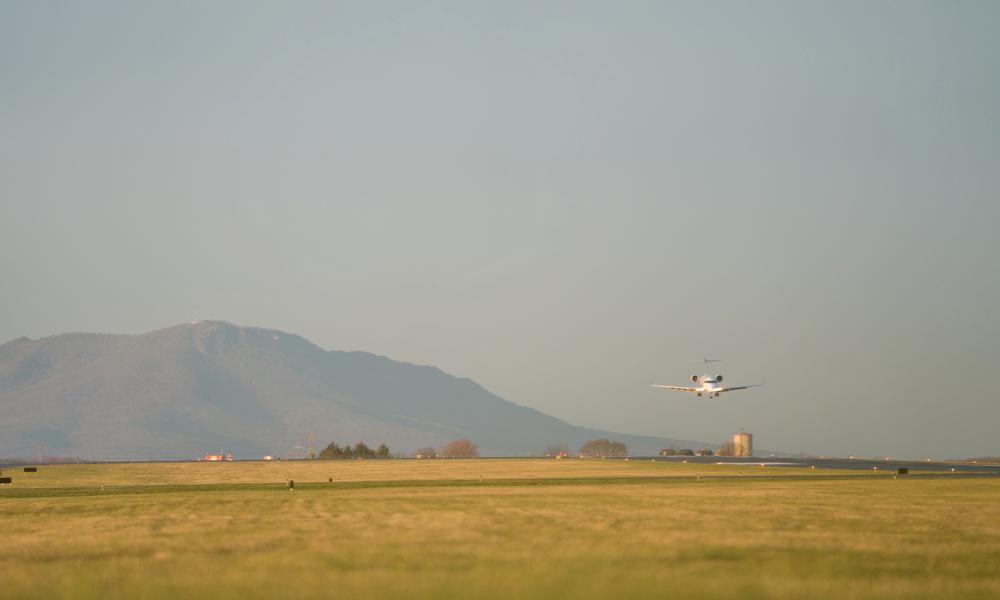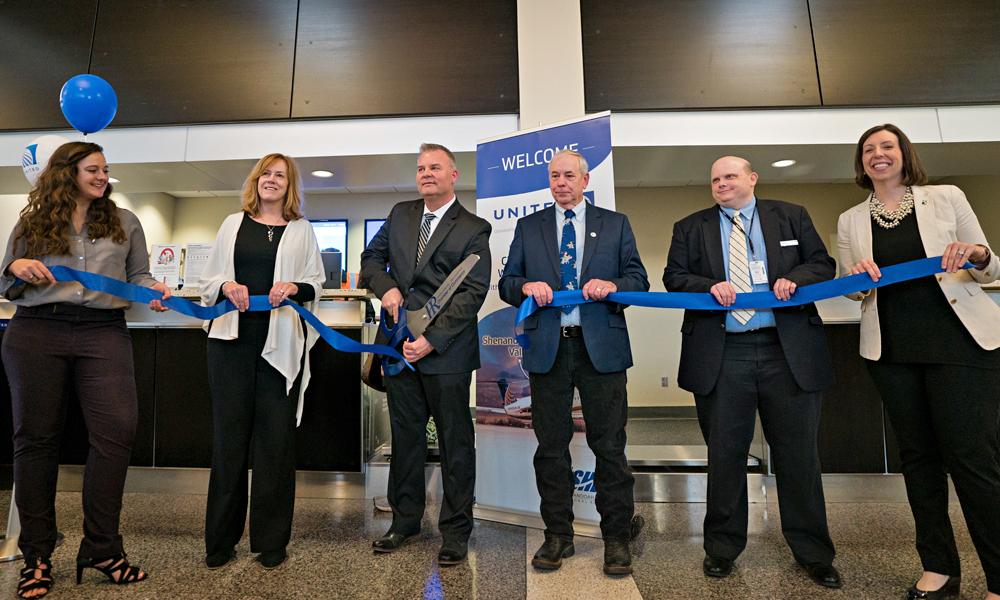Aiming higher
NewsSUMMARY: With daily flights to and from United Airlines' hubs at Dulles International and Chicago O'Hare, Shenandoah Valley Regional Airport is bringing JMU closer to the world.
from the Fall 2018 issue of Madison
By Jim Heffernan ('96, '17M)
JMU’s setting has long been a selling point—a beautiful campus in a friendly city just two hours from the nation’s capital, surrounded by rolling farmland and breathtaking views of the Blue Ridge Mountains, with a wealth of historical, cultural and recreational attractions nearby.
But that location, at times, can also be a liability. For visitors and guests originating outside of Virginia and neighboring states, a trip to Harrisonburg often means flying into a busy airport in Washington, D.C., Richmond or Charlottesville and renting a car for the drive to campus. The reverse is true for members of the JMU community looking to travel for business, academic conferences and leisure.
Not anymore.
 |
Shenandoah Valley Regional Airport in Weyers Cave now offers daily flights to and from Chicago O’Hare and Dulles International airports aboard United Express. As a result, JMU faculty, staff and students have convenient access to hundreds of United’s destinations in the U.S. and around the world, and alumni, parents and visitors to the university can reach campus more easily than ever.
United and its partner, SkyWest Airlines, launched the service to great fanfare during a ceremony in April at the regional airport that drew local government and industry leaders, university officials and residents. The first United Express 50-seat Bombardier CRJ200 jet touched down about 7:15 that evening and departed an hour later with approximately 20 passengers on board, including JMU faculty and staff. The plane arrived back in Weyers Cave just after 11 p.m., carrying, among others, JMU President Jonathan R. Alger and his wife, Mary Ann, who were returning from Texas.
JMU’s presence was a factor in Utah-based SkyWest’s decision to enter the local market. “For any new air service to be successful, you need strong players in the community, and JMU is a big player,” says SkyWest spokesperson McKall Morris. “We see a lot of potential here in the Shenandoah Valley.”

“This new service is critical for JMU and its ability to attract students, faculty and staff, and really to raise the profile and grow the university over time,” adds Greg Campbell, executive director of Shenandoah Valley Regional Airport. “We think having this type of convenient, global access with a major airline partner will be a major benefit.”
Service at Shenandoah Valley Regional Airport was spotty under previous carriers, but officials believe they have found the right partner in SkyWest. “It’s reliable service that the community can count on,” Campbell says, “and that’s reflected in the passenger traffic we’ve seen in the first few months of operation. We’re seeing significant increases over what the airport has seen before.”
|
'It's reliable service that the community can count on.' — Greg Campbell, executive director, Shenandoah Valley Regional Airport |
JMU faculty and staff are among those who are on board.
Nick Swartz, associate dean of outreach and engagement at JMU and a professor of public policy and administration, was on the inaugural flight. “It took 17 minutes to get from Shenandoah Valley Regional Airport to Dulles. That was impressive.”
“In today’s world, with all the moving parts and busy agendas and wanting to maximize your time, having a local airport that’s 20 minutes from campus is terrific,” says Melissa Lubin, dean of outreach and engagement at JMU. “The drive here is beautiful. It’s a lot less hassle going through the gates and checking your baggage. There are a lot of advantages that you’re just not going to get at a larger airport.”
JMU Director of Athletics Jeff Bourne believes the service will enhance the student-athlete experience. “Having United-SHD available to us is going to make our time much more efficient. Our student-athletes are brought in from many parts of the country, so the fact that they can get the service and get it in a timely manner helps both the brand of JMU Athletics and our university.”
Shenandoah Valley Regional Airport offers an unparalleled passenger experience, Campbell says. Travelers can move through the facility quickly, and the airport applies the federal Transportation Security Administration standards as large metropolitan airports. Parking is free, there are three rental car kiosks located inside the terminal, and shuttle service is available for guests of the new Hotel Madison and Shenandoah Valley Conference Center.
The new service will allow JMU to support the local economy while furthering its own mission.
“JMU has an enormous footprint in the region,” says Carrie Chenery, executive director of the Shenandoah Valley Partnership, a regional economic development group affiliated with JMU. “You have 20,000–30,000 students cycling in every year, parents, alumni, visitors to campus, conferences. Beyond that, you have the institutional knowledge, the human capital, the potential for the university to reach across the world, for the graduates who are being produced, for the research that’s happening, for the world-class programs that are being developed.”
JMU’s goal to be the national model for the engaged university requires that “we engage with neighboring communities, neighboring states and other countries,” Swartz says. “That’s our presence and our footprint across the entire world. Having a major airline that’s 20 minutes from campus is a game-changer for the university.”
In planning for JMU’s Engagement for the Public Good conference at Hotel Madison in November, President Alger made clear his desire to attract a national audience. “In order to make that happen, we need to be accessible,” Lubin says. “Participants need to be able to get here easily. Having a service that’s associated with United is great because United goes everywhere. Most places, it’s going to take one connection, and that’s as good as anybody else can do it that is close by. That will be a big plus in drawing people here.”
Campbell says as word continues to spread about the availability of the service, how reliable it is, how well timed and connected it is with United’s two hubs, he expects traffic to continue to increase throughout the fall and into next year.
Support from the JMU community is critical, Campbell says, not only to sustain the service, but also to be able to expand the airport’s commercial service offerings over time to include additional carriers. “It will allow our local airport to grow along with the university and to meet the needs of a growing community.”


